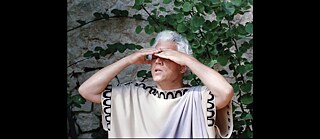|
8:00 PM
Der Tod des Empedokles + Harun Farocki: Filmtip: Der Tod des Empedokles
Film Screening
-
Close-Up Film Centre, London
- Part of series: The Films of Jean-Marie Straub and Danièle Huillet

Friedrich Hölderlin’s drama The Death of Empedocles is a tragedy on the death of the pre-Socratic Greek thinker and poet Empedocles of Acragas, composed in three incomplete versions from 1798 to 1799 and never published during the poet’s lifetime. The filmmakers are faithful to the text of Hölderlin’s first version: the first act deals with the political dispute and banishment of Empedocles from the city and the second with the philosopher’s conflict with the gods, his argument about the value of life and his decision to end his life in the volcanic crater of Mount Etna. After eighteen months of rehearsals with the remarkable actors cast for the film, the filmmakers staged this ‘oratorio without music’ in exterior locations in Sicily using direct sound and the existing surrounding light. All the elements at play in the film, words, sounds, the gestures, light and nature, exert a force and tension that gives this film its telluric and vivid strength.’
In Filmtip: The Death of Empedocles made for German television, Harun Farocki talks to Andreas Rauch, who plays Empedocles in the film by Huillet and Straub.
The screening will be introduced by Silvia Maglioni and Graeme Thomson.
Der Tod des Empedokles oder: Wenn dann der Erde Grün von neuem euch erglänzt, The Death of Empedocles, or When the Green of the Earth Will Glisten for You Anew, Dirs: Jean-Marie Straub and Danièle Huillet, West Germany, 1987, 35mm/DCP, colour, 132 min., German with English subtitles.
Filmtip: Der Tod des Empedokles, Filmtip: The Death of Empedocles, Dir: Harun Farocki, West Germany, 1987, 16mm/Digital, colour, 7 mins., in German with English subtitles.
Siliva Maglioni and Graeme Thomson's artists' presentation Border Struggles (of the Common Birds) as part of retrospective takes place on Thursday, 16 May 2019, at the Whitechapel Gallery.
In Filmtip: The Death of Empedocles made for German television, Harun Farocki talks to Andreas Rauch, who plays Empedocles in the film by Huillet and Straub.
The screening will be introduced by Silvia Maglioni and Graeme Thomson.
Der Tod des Empedokles oder: Wenn dann der Erde Grün von neuem euch erglänzt, The Death of Empedocles, or When the Green of the Earth Will Glisten for You Anew, Dirs: Jean-Marie Straub and Danièle Huillet, West Germany, 1987, 35mm/DCP, colour, 132 min., German with English subtitles.
Filmtip: Der Tod des Empedokles, Filmtip: The Death of Empedocles, Dir: Harun Farocki, West Germany, 1987, 16mm/Digital, colour, 7 mins., in German with English subtitles.
Siliva Maglioni and Graeme Thomson's artists' presentation Border Struggles (of the Common Birds) as part of retrospective takes place on Thursday, 16 May 2019, at the Whitechapel Gallery.
Related links
Location
Close-Up Film Centre
97 Sclater Street
London E1 6HR
United Kingdom
97 Sclater Street
London E1 6HR
United Kingdom
Location
Close-Up Film Centre
97 Sclater Street
London E1 6HR
United Kingdom
97 Sclater Street
London E1 6HR
United Kingdom